Yuewen Cao
OmniCaptioner: One Captioner to Rule Them All
Apr 09, 2025Abstract:We propose OmniCaptioner, a versatile visual captioning framework for generating fine-grained textual descriptions across a wide variety of visual domains. Unlike prior methods limited to specific image types (e.g., natural images or geometric visuals), our framework provides a unified solution for captioning natural images, visual text (e.g., posters, UIs, textbooks), and structured visuals (e.g., documents, tables, charts). By converting low-level pixel information into semantically rich textual representations, our framework bridges the gap between visual and textual modalities. Our results highlight three key advantages: (i) Enhanced Visual Reasoning with LLMs, where long-context captions of visual modalities empower LLMs, particularly the DeepSeek-R1 series, to reason effectively in multimodal scenarios; (ii) Improved Image Generation, where detailed captions improve tasks like text-to-image generation and image transformation; and (iii) Efficient Supervised Fine-Tuning (SFT), which enables faster convergence with less data. We believe the versatility and adaptability of OmniCaptioner can offer a new perspective for bridging the gap between language and visual modalities.
Lumina-Video: Efficient and Flexible Video Generation with Multi-scale Next-DiT
Feb 10, 2025Abstract:Recent advancements have established Diffusion Transformers (DiTs) as a dominant framework in generative modeling. Building on this success, Lumina-Next achieves exceptional performance in the generation of photorealistic images with Next-DiT. However, its potential for video generation remains largely untapped, with significant challenges in modeling the spatiotemporal complexity inherent to video data. To address this, we introduce Lumina-Video, a framework that leverages the strengths of Next-DiT while introducing tailored solutions for video synthesis. Lumina-Video incorporates a Multi-scale Next-DiT architecture, which jointly learns multiple patchifications to enhance both efficiency and flexibility. By incorporating the motion score as an explicit condition, Lumina-Video also enables direct control of generated videos' dynamic degree. Combined with a progressive training scheme with increasingly higher resolution and FPS, and a multi-source training scheme with mixed natural and synthetic data, Lumina-Video achieves remarkable aesthetic quality and motion smoothness at high training and inference efficiency. We additionally propose Lumina-V2A, a video-to-audio model based on Next-DiT, to create synchronized sounds for generated videos. Codes are released at https://www.github.com/Alpha-VLLM/Lumina-Video.
DiffSVC: A Diffusion Probabilistic Model for Singing Voice Conversion
May 28, 2021


Abstract:Singing voice conversion (SVC) is one promising technique which can enrich the way of human-computer interaction by endowing a computer the ability to produce high-fidelity and expressive singing voice. In this paper, we propose DiffSVC, an SVC system based on denoising diffusion probabilistic model. DiffSVC uses phonetic posteriorgrams (PPGs) as content features. A denoising module is trained in DiffSVC, which takes destroyed mel spectrogram produced by the diffusion/forward process and its corresponding step information as input to predict the added Gaussian noise. We use PPGs, fundamental frequency features and loudness features as auxiliary input to assist the denoising process. Experiments show that DiffSVC can achieve superior conversion performance in terms of naturalness and voice similarity to current state-of-the-art SVC approaches.
VARA-TTS: Non-Autoregressive Text-to-Speech Synthesis based on Very Deep VAE with Residual Attention
Feb 12, 2021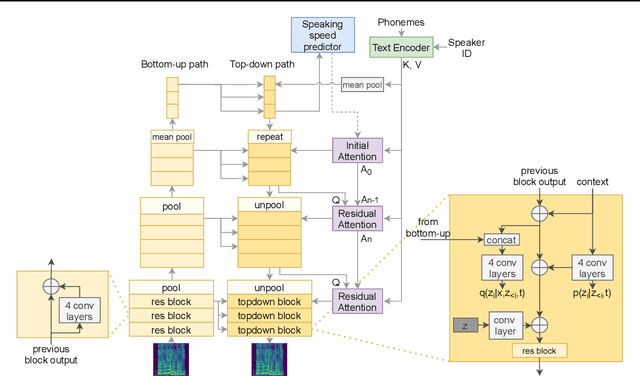
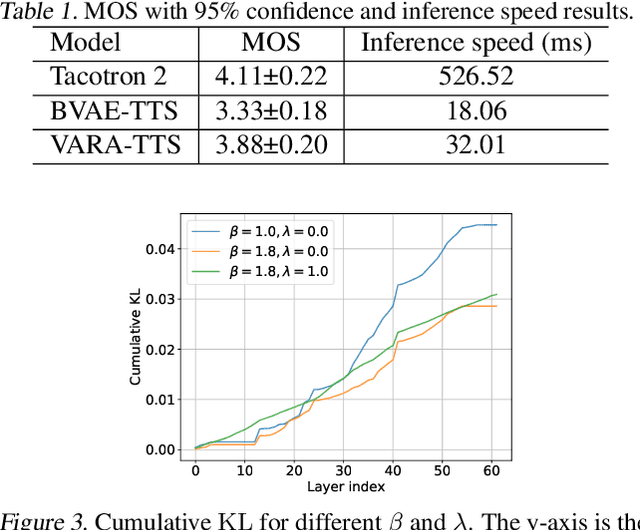
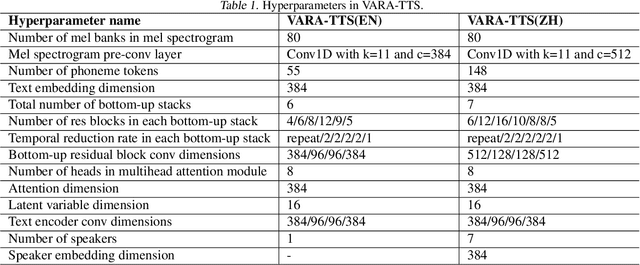
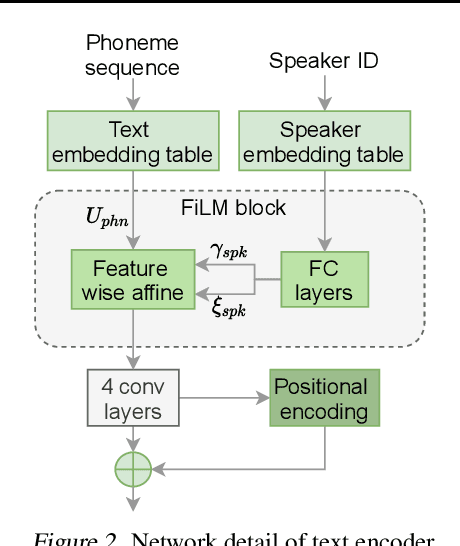
Abstract:This paper proposes VARA-TTS, a non-autoregressive (non-AR) text-to-speech (TTS) model using a very deep Variational Autoencoder (VDVAE) with Residual Attention mechanism, which refines the textual-to-acoustic alignment layer-wisely. Hierarchical latent variables with different temporal resolutions from the VDVAE are used as queries for residual attention module. By leveraging the coarse global alignment from previous attention layer as an extra input, the following attention layer can produce a refined version of alignment. This amortizes the burden of learning the textual-to-acoustic alignment among multiple attention layers and outperforms the use of only a single attention layer in robustness. An utterance-level speaking speed factor is computed by a jointly-trained speaking speed predictor, which takes the mean-pooled latent variables of the coarsest layer as input, to determine number of acoustic frames at inference. Experimental results show that VARA-TTS achieves slightly inferior speech quality to an AR counterpart Tacotron 2 but an order-of-magnitude speed-up at inference; and outperforms an analogous non-AR model, BVAE-TTS, in terms of speech quality.
Any-to-Many Voice Conversion with Location-Relative Sequence-to-Sequence Modeling
Sep 06, 2020
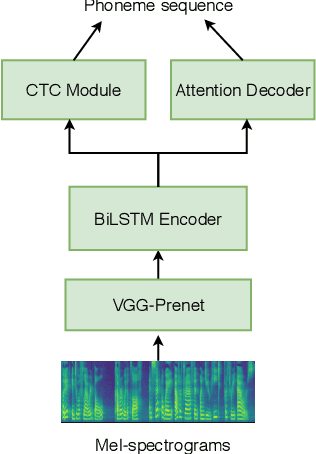
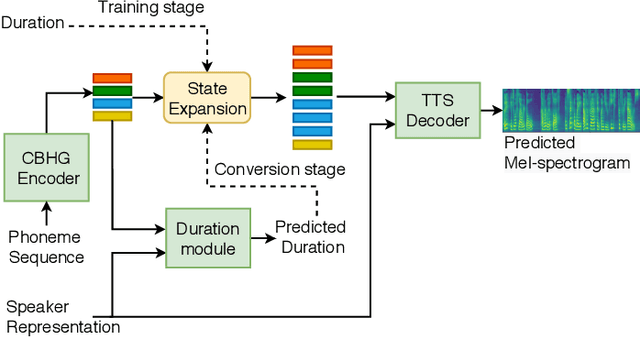

Abstract:This paper proposes an any-to-many location-relative, sequence-to-sequence (seq2seq) based, non-parallel voice conversion approach. In this approach, we combine a bottle-neck feature extractor (BNE) with a seq2seq based synthesis module. During the training stage, an encoder-decoder based hybrid connectionist-temporal-classification-attention (CTC-attention) phoneme recognizer is trained, whose encoder has a bottle-neck layer. A BNE is obtained from the phoneme recognizer and is utilized to extract speaker-independent, dense and rich linguistic representations from spectral features. Then a multi-speaker location-relative attention based seq2seq synthesis model is trained to reconstruct spectral features from the bottle-neck features, conditioning on speaker representations for speaker identity control in the generated speech. To mitigate the difficulties of using seq2seq based models to align long sequences, we down-sample the input spectral feature along the temporal dimension and equip the synthesis model with a discretized mixture of logistic (MoL) attention mechanism. Since the phoneme recognizer is trained with large speech recognition data corpus, the proposed approach can conduct any-to-many voice conversion. Objective and subjective evaluations shows that the proposed any-to-many approach has superior voice conversion performance in terms of both naturalness and speaker similarity. Ablation studies are conducted to confirm the effectiveness of feature selection and model design strategies in the proposed approach. The proposed VC approach can readily be extended to support any-to-any VC (also known as one/few-shot VC), and achieve high performance according to objective and subjective evaluations.
 Add to Chrome
Add to Chrome Add to Firefox
Add to Firefox Add to Edge
Add to Edge